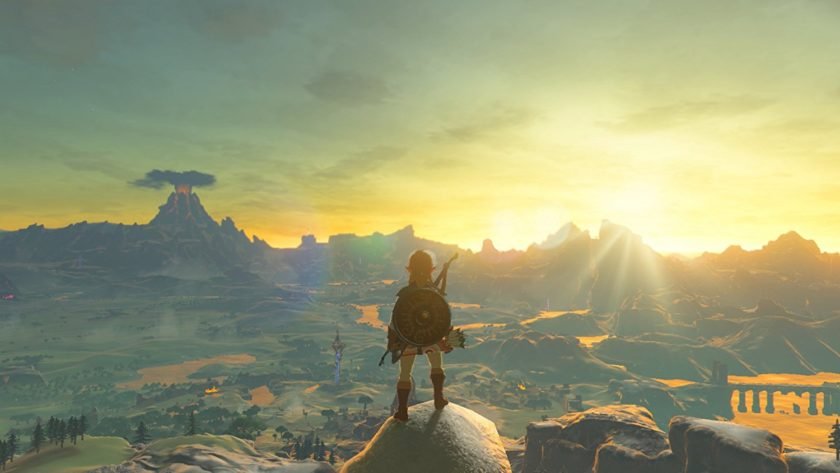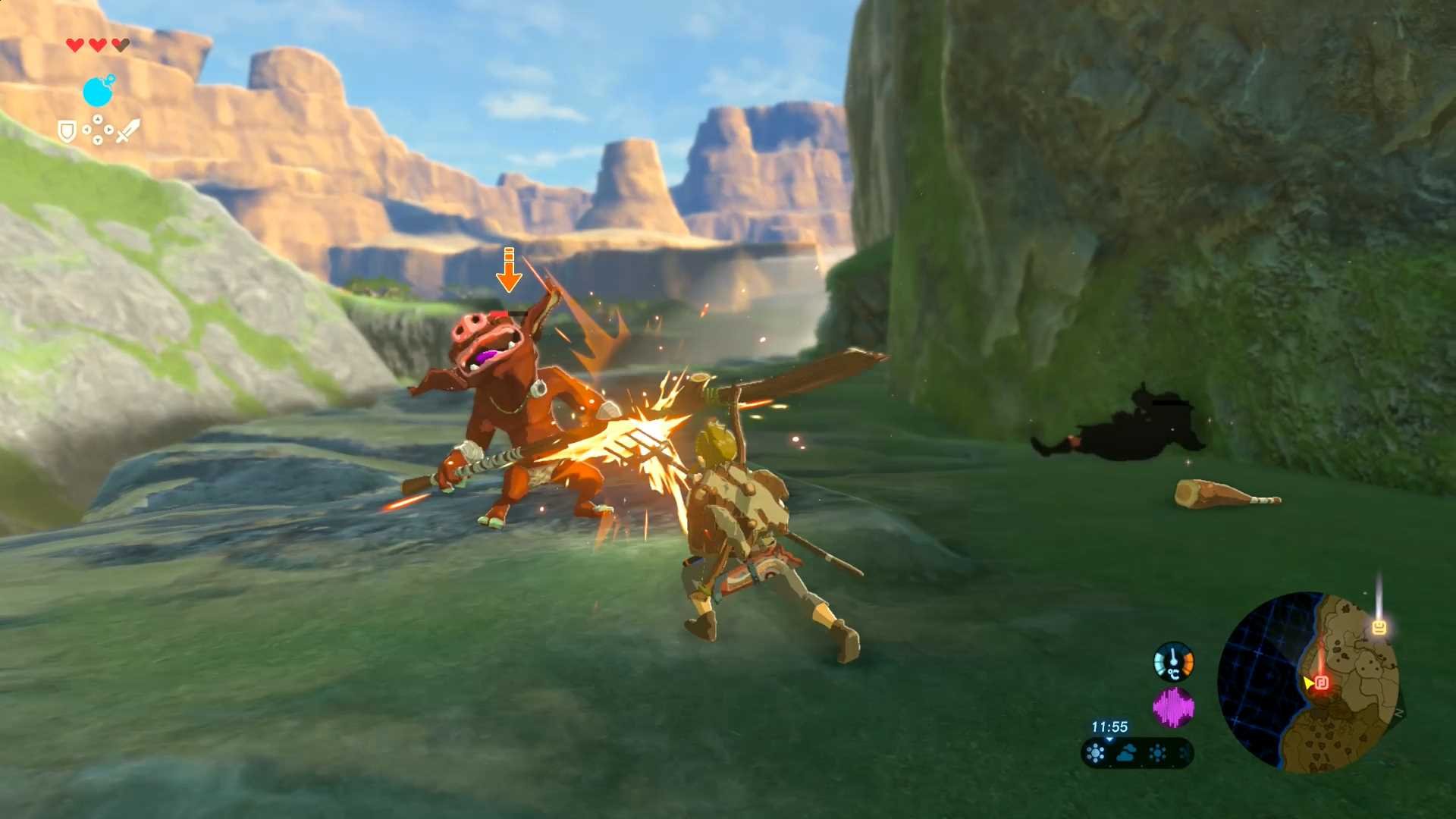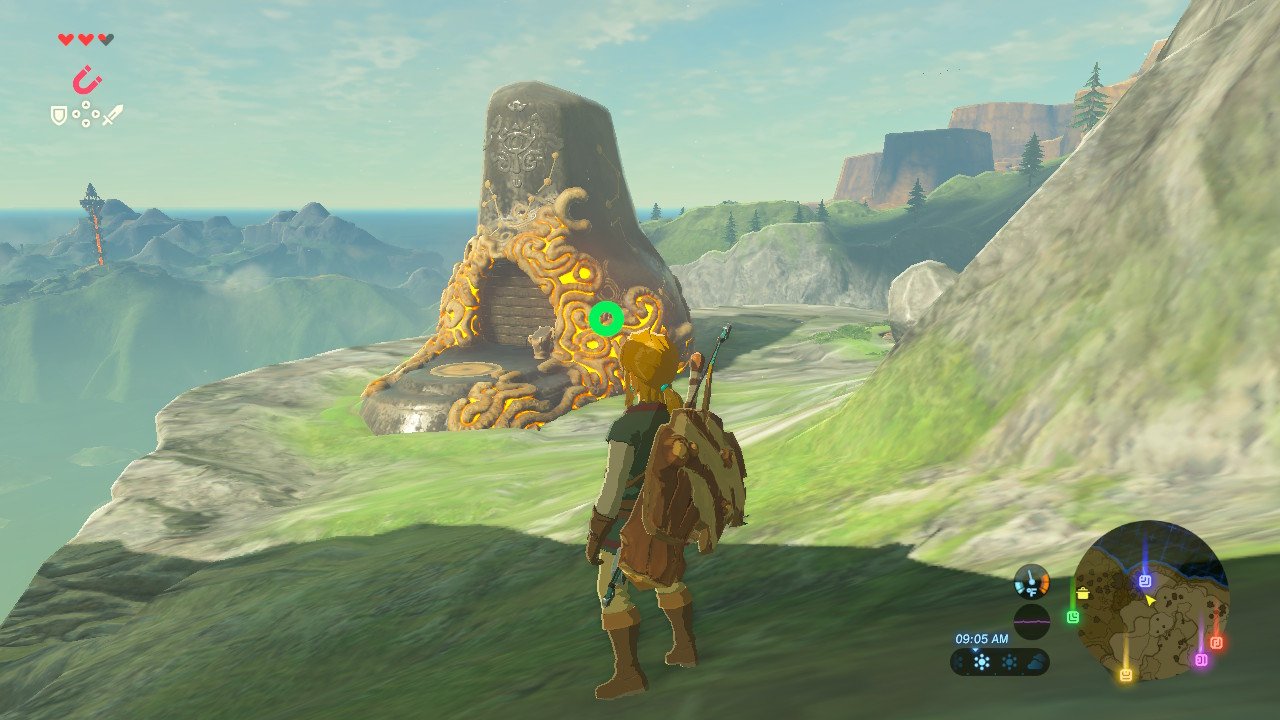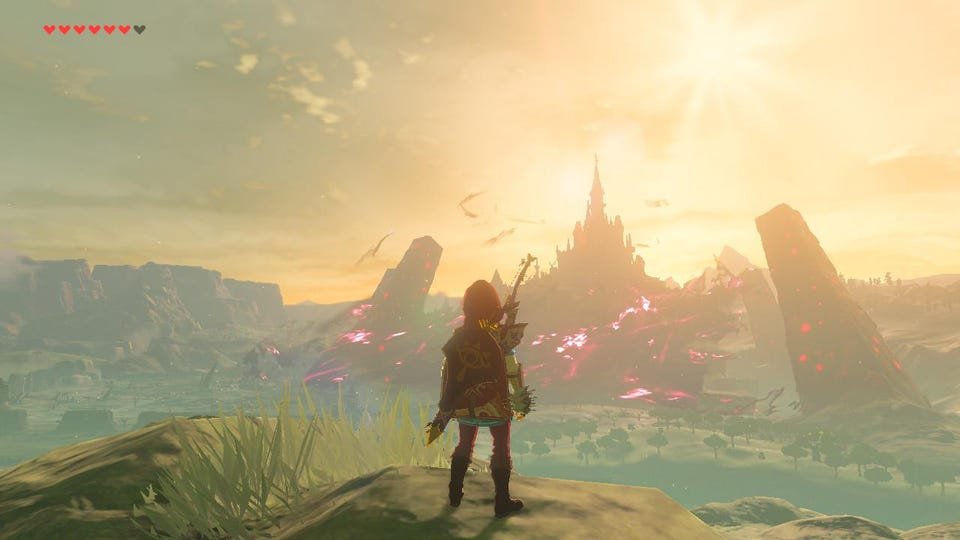Legend of Zelda: Breath of the Wild - In Review
Every now and again, you get that itch for adventure. Then you remember your holiday is a bit far away. So instead you spin up a game and dive headfirst into an otherworldly realm, letting your imagination wander as you explore the possibilities. There've been many great attempts to capture this feeling, one of my favourites being Okami, where you explore a gorgeous Japanese brush-painted landscape you can not only explore, but can interact with by painting over it. Maybe you prefer to parkour over a zombie-infested city, ducking and diving in order to craft weapons and complete objectives in Dying Light. Perhaps you want to simply race across a desolate, post-apocalyptic world and beat up maniacs to upgrade your car in Mad Max. The one that seems to stand head and shoulders above the rest though, at least in my mind, is Legend of Zelda: Breath of the Wild.
Where other open-world games have provided a worthy escape into unknown lands, this game elevates this to a whole new level. It adds interactivity with the environment in so many interesting ways that now, 5 years on, there are still players finding brand new ways to achieve their goals. Come and join me on a journey to discover why this is more than simply a worthy escape, and is a world to be deservingly savoured.
The Great Plateau Beckons
Our hero by the name of Link awakens in a mysterious cave, known later as the Shrine of Resurrection. You walk over to a large glowing stalactite-looking object and (after a rather beautiful animation) pick up your first vital item; a Skeikah Slate. This object is cleverly designed as it resembles a modern tablet, and feels powerful yet ancient. You find and put on your ragged clothes and head out. Immediately upon exiting the cave, you are then greeted by the astonishing vista of the world of Hyrule, and the game then introduces itself in the now iconic moment.
As you head down a hill to the right, you stumble into a mysterious hooded figure by a campfire who guides you to your first destination. As you approach, a place to insert your slate is revealed. Once inserted, a giant Sheikah Tower thrusts itself from beneath you, and all around the map others heave upwards into existence. The vastness of the landscape becomes clear when you are shown the map of The Great Plateau. This area serves as a sandbox to get your bearings with some of the systems in the game. It is now evident that activating towers is how you will also map new areas.
Into the Heat of Battle
Once you unearth the tower, you will be tasked to reach a few locations in the Great Plateau, in order to upgrade your Sheikah Slate. While on your journey however, you run into some trouble along the way. Suddenly a Bokoblin (a goblin-like creature) notices you, which triggers a frantic search for a weapon. You then realise you don’t have one. But then you remember that tree branch you picked up a little while ago and start swatting. Then the tree branch breaks.
Unlike many other open-world games, you not only have an economy based in rupees (the in-game currency) but also another for weapons in a manner of speaking. Most weapons you pick up have limited durability. You will need to strategize and decide which fights to take on, but also which weapons to use and in what order. It provides a good motive for picking the right tool for the right job.
After wandering about for a while, you find your first rusty weapon. Not the most durable, but it will do the job for now. “Huzzah!”, you cry, “Finally a weapon!”. You then give that pesky Bokoblin a good old-fashioned battering. Then they drop their spear. “A spear?” you think to yourself, searching for another opponent to test on. Once found, you then proceed to machine-prod them into oblivion, they can’t even get near you. Each weapon type carries its own qualities. You may have the traditional sword and shield, or a two-handed claymore that’s powerful but negates the ability to parry, as you can’t carry a shield. Some even have functions other than as mere weaponry such as axes. Finding new weapons is always a joy.
There are also other methods to make the most of your gear. If a dodge is successfully executed with good timing, this will allow you to retaliate with a flurry rush; a series of hyper-fast hits against the opponent. If your melee weapon is about to break, you may as well throw it at them…..which you can. The weapon will inevitably shatter on hit, but will deal double damage in a pinch if needed. Of course the game also has bows as an option to attack from a distance, with excellent Joy-Con motion controls for fine-tuning your aim.
A final consideration in combat basics is the handy colour-coding of enemies. The first Bokoblin you will meet is likely to be red, the lowest level. Later on, other colours will represent increasing levels. Not only do enemies become tougher with level, but they develop new and sometimes unexpected attacks and movements. They will also become more resilient, even immune to certain attacks and statuses. More than anything then, the enemies feel increasingly battle-hardened.
The Fruits of Labour
With every battle comes a need to recuperate and build resilience. There are two main forms of energy Link will need to tackle this great landscape; health and stamina. Health is pretty self-explanatory, you start with three hearts and if they run out you die. Stamina is the more interesting aspect here, as it dictates how much of or how long a given action can be performed before becoming exhausted. Actions that can be performed are numerous, for example; sprinting, climbing and charge attacks with your weapon.
At some point you will need to survive on more than those apples you climbed a tree to retrieve. With that comes Breath of the Wild’s excellent recipe system. Every good recovery item is either some sort of meal or elixir. With the ingredients or monster parts you accumulate, you can create whatever your heart desires, whether it’s an omelette or a fancy cake. The more gourmet the ingredients, the higher the potency. Just find your nearest campfire complete with a cooking pot and start chucking stuff together, it’s always fun discovering new recipes!
Meals are great at recovering health, but if combined with special ingredients they can also have status effects. The first you are likely to locate is the spicy pepper. In the Great Plateau, there is a cold mountainous region and you will need this to cook a warming meal, otherwise you will freeze. Elixirs will also have effects, except using monster parts and critters (bugs, frogs, etc.), with no real health regeneration usually. Experiment with this for yourself, and you will see how versatile the effect buffs can be. Be careful not to mix the wrong ingredients together however, otherwise the result will be something rather vile.
Alongside the recipe system, it is also necessary to hunt for pieces of armour to bolster your defences and increase your overall resilience. The number next to these will determine the level of defence (and incidentally the number next to weapons also dictates their level of strength). Over time, this can also be upgraded with all the items you may be hoarding at a wonderful place; a Great Fairy Fountain. The more of these you find, the stronger your armour can become, and eventually can have additional effects.
The Art of Discovery
We now move onto possibly the best part about this game. It’s time to step out of the Great Plateau and into the world of Hyrule at large, and talk about some aspects in more detail.
There will be many, many things to discover. You will have already entered and completed a few puzzle areas called shrines (not unlike tombs in the newer Tomb Raider series) in the Great Plateau. Out in the wide world these are everywhere. The shrines range from combat trials, to mental and physical puzzles (some with excellent motion controls once again), or even in some cases simply entering after completing a Shrine Quest. Talk to folk regularly to uncover secrets such as these. Once a shrine is detected, your Slate will bleep faster as you near one. I advise to locate these as and when detected, as they act as fast travel points on the map. They are satisfying to complete and can provide great loot, but also help extend your health and stamina bars using the spirit orbs awarded on completion at prayer statues.
But let’s get to the other fun stuff; the Sheikah Slate Runes. These expose the rather exquisite physics system, which is so good that many of the shrines and key parts of the game depend on it, and make the ah-ha moments of discovery oh so satisfying. No strange, floaty physics here.
Round and Square Bombs can lay a bomb that is lighter that it looks, useful for enemies or broken walls. Stasis allows you to stop objects for a while. A clever part of this is hitting the object repeatedly with, say, a hammer will cause it to shoot into the opposite direction upon the timer running out. Cryonis allows you to summon large, climbable ice cubes in water, handy for say crossing a river if there isn’t enough stamina in the tank for swimming.
One of my most commonly used though is Magnesis. This excellent ability can be used to control metallic objects ranging from crates, to weapons, even treasure chests at the bottom of a body of water. Admittedly, one of my guilty pleasures is using a metal crate to push an unsuspecting Bokoblin off a ledge. There are always new and interesting ways to discover when using Runes.
My advice is to follow your curiosity, as the game seems designed with this in mind - an aspect where many open world games have previously failed. One big reason to do this is Koroks. These are cute little masked wood-sprite creatures that you will find hiding around the map and they are EVERYWHERE. If you see a circle of rocks on the ground, but one missing, find and place a rock there and blam……Korok. See a circle of lilies in a pond? Dive into it and blam……Korok. See a boulder-shaped hole in the ground? Smack one into it using Stasis and……you get the idea. Finding these will award you Korok Seeds, which allows you to expand your inventory via our cheerful maraca-wielding Korok friend Hestu. Feel free to take a small diversion once in a while.
Exposed to the Elements
Exploring the wonderful landscape of Hyrule is a feeling that is difficult to encapsulate in full. You have the birdsong and crickets, the breeze that sways the grass and the occasional broken arpeggio on the piano accentuating the wild in subtle ways. Even strolling through the long grass as it parts around you, you can almost taste and smell the vast ecosystem as if you were actually there. It’s important to keep in mind just how you can affect this environment, and how much it can affect you when you least expect it.
In the land of Hyrule, you will often find yourself contesting its weather systems. Some environments will be extremely hot, cold or simply harsh due to adverse weather conditions. Alongside the physics model, working hand-in-hand with this is the elemental side of the game. This can lead to some rather interesting interactions discussed later.
The weather can present many challenges. One of the most common is when you are climbing, which you do A LOT while exploring Hyrule as nearly all terrain can be traversed (provided you have the stamina for it). Once it starts raining however, surfaces become slippery and Link can barely make his way up anything. Another example is in the volcanic environment. Here, any wooden weapons equipped set on fire and can burn to ash if unchecked. A humerous example of the weather system was with my bow. I had this equipped and spotted a bunch of enemies over yonder. I drew my bow with great enthusiasm, and promptly exploded. Confused, I once again rose up and drew my bow, then exploded again. After cursing expletives and shaking my fist at the enemies for a while, I came to the realisation that it probably wasn’t wise to equip bomb arrows in a volcanic environment.
Used correctly however, these conditions can be turned in your favour. While it is raining, any lightning-based weaponry gets a large boost and creates a field, disarming enemies of their weapons in a larger radius and causing more damage. Also in the volcanic environment, any regular arrow you draw will ignite and become a fire arrow, saving a fair few rupees.
Let’s set up an example of how these systems can be harnessed in battle using our nemesis, the Octorok. These balloon-like enemies can be quite irritating, firing rocks with pinpoint accuracy at your face. Once defeated they provide you with Octorok Balloons, which when tied to an object will cause it to float upwards. Tying one of these to an explosive barrel can float it to a base that is higher up. When it then reaches the right spot, a loosed fire arrow can ignites the barrel, sending nearby enemies to kingdom come!
One final mention is the time of day. During normal daytime hours it’s business as usual, however during night-time there are more enemies that spawn in, as in other games such as Minecraft. On occasion however, an event occurs that respawns all previously defeated enemies; a Blood Moon. We haven’t spoken ill of this game as of yet, however I feel this is a weaker aspect. In relation to the frequency of the announcements, I’ve not felt it really impacted me in a meaningful way as all it appears to do is respawn enemies. I’ve seen this better executed in games such as Terraria, where the enemies kept on spawning in an attempt to overrun, battering doors down and closing in on the player, while they wished it would all end as soon as possible. That was a rush.
A Noble Cause
With all this said and done, let’s get onto the main quest line. Upon exiting the Great Plateau, you are immediately presented with the end game objective; to defeat the evil known as Calamity Ganon, that has taken over Hyrule Castle and is draining Princess Zelda as she attempts to delay it from spreading throughout Hyrule. It is highly unusual for a game to reveal the end objective with a map marker so early. It tempts you, reminding you that this can be approached in your own time, however it would probably be suicidal for a first-time player to do this straight away. Instead, there is another objective to reach Kakariko Village.
After sprinting around for a while, you may be wondering how on earth to speed up the pace on your journey given the size of the map. By this point you should have hopefully reached a stable. These are scattered about the land, and can be used to register and summon your very own horse. This companion will serve as your trusty steed, however when you first manage to tame one, it doesn’t do this straight away. It may go in a different direction than intended or get restless. With enough soothing however, over time the bond will grow stronger and the horse will obey more frequently. You can then relax to the beautiful staccato of the piano alongside the galloping horse.
Upon reaching the village you will learn of four mighty Divine Beasts that have unfortunately come under control of evil and are now causing havoc. They appear on the map in different corners and require separate challenges in order to reach each one. This involves reaching each of four nations; the merfolk-like Zora, the birds of Rito, the all-female Gerudo tribe and the rather hefty Goron. All of these tribes have their own distinctive differences and are all very charming to explore.
Along the way, you will also stumble upon memories of Link’s past from a bunch of photos on the Sheikah Slate, which neatly tie together the characters and story. The story aspect is a little more infrequent in this compared to other open word titles, however I feel this works in its favour and gives space, allowing you to fill in your adventure.
Moving on to the divine beasts, these involve both puzzle solving and precise combat to tame. Each of these revolve around their own overarching mechanic and are satisfying to complete. The first divine beast you are likely to head towards (as I did) would be that in the Zora domain, as this is nearer to Kakariko Village than the rest. Once reached, I spent a couple of hours taming the divine beast there, and after finally completing this I felt satisfied and looked forward to the rest.
However the game fell a bit flat here with difficulty balancing for me. I found the other beasts to be much easier in varying levels. You may be thinking here that this is simply because I improved at the divine beasts, but I beg to differ. Referring back to Hollow Knight, the difficulty curve was such that every boss was tricky but each gave different challenges that still felt fresh and testing, as well as individually rewarding. The mechanic ideas for each Divine Beast were all great designs, but the difference in difficulty means that you could be thinking there is supposed to be an order, which can be counter-intuitive to the non-linear adventure.
We then get onto Calamity Ganon. I will not spoil anything here, but will say that this is an epic-feeling battle as you’d expect. What I did not expect, however, was to beat it in one shot. Somehow, this was easier than any other boss faced, which I thought was strange at the time. The finale confrontation of any game should be a well-fought and satisfying end. Again referring to Hollow Knight, the final boss was tough. Took quite a few tries, but when it was finally beaten I exhaled a sigh of relief and satisfaction at the mountain I had just climbed. And that was with all my gear upgraded to max.
Summary
The Legend of Zelda: Breath of the Wild is truly a magnificent masterpiece. It is an incredible world full of curious interactions that will be different every time you play it. If you have tried previous open-world games just to check that nook over there only to find nothing, this is the game you’ve always wanted. Every discovery is a reward, every battle is a story. The only aspects that bring this down slightly are the questionable difficulty balancing in climactic parts of the main quest and the underwhelming blood moon. These are quite minor points however. For everything else, you will more than enjoy your time exploring and sometimes contesting the utterly beautiful Hyrule and savour every breath in this simply stunning adventure.









